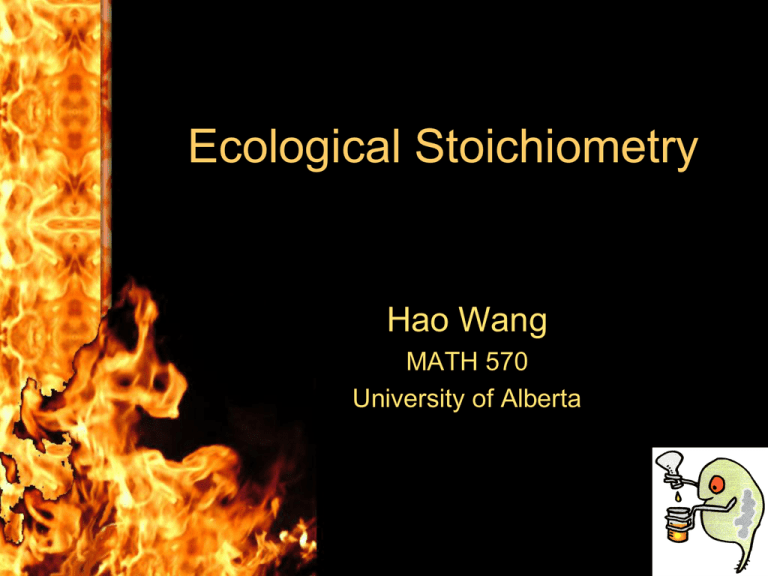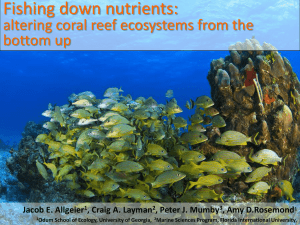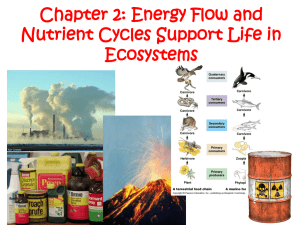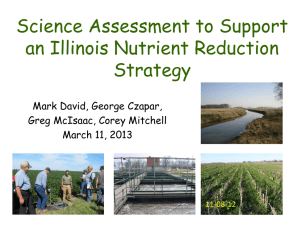Ecological stoichiometry
advertisement

Ecological Stoichiometry
Hao Wang
MATH 570
University of Alberta
What is STOICHIOMETRY?
Stoichiometry in chemistry: Focuses on the balance of
elements within chemical equations.
Stoichiometry in biology: Focuses
on the balance of elements and
energy within biological systems.
This includes metabolism, growth,
etc.
Stoichiometry in ecology: Focuses
on the balance of elements and
energy within ecological systems.
This includes competition,
commensalisms, etc.
Why need STOICHIOMETRY?
Carbon (C), nitrogen (N), and phosphorus (P) are vital
constitutes in biomass: C supplies energy to cells, N is
essential to build proteins, and P is an essential component
of nucleic acids. The scarcity of any of these elements can
Severely restrict organism and population growth.
What would happen to cows
if there wasn't so much sunlight?
Expectations from a 9-year old ecologist
James J. Elser’s
son
Primary Production,
Autotroph Biomass
What would happen to secondary production
if solar radiation were reduced?
Expectations from single-currency ecological theory
Solar Radiation
High
Secondary Production,
Herbivore Biomass
Low
Low
Solar Radiation
High
Stoichiometric Imbalance Impairs Herbivores
In Freshwater and Terrestrial Ecosystems
Freshwater herbivore (Daphnia)
Terrestrial herbivore (Pieris)
25
20
15
10
5
mean
Pieris rapae 10%
0
0
10
20
30
90%
(59)
40
Biomass C:N in Food
Mass of New Biomass Produced
GGE(gross growth efficiency)=
Mass Ingested
From: Elser, J.J., W.F. Fagan, R.F. Denno, D.R. Dobberfuhl, A. Folarin, A. Huberty, S. Interlandi, S.S. Kilham, E. McCauley, K.L. Schulz, E.H.
Siemann, and R.W. Sterner. 2000. Nutritional constraints in terrestrial and freshwater food webs. Nature 408: 578-580.
Secondary Production,
Herbivore Biomass
Low
Solar Radiation
Starvation
High
Very High
Junk food
(CXNYPZ)inorganic + (CXNYPZ) autotroph + light -> Q (CXNYPZ)' autotroph + (CXNYPZ)’ inorganic
(CXNYPZ)prey + (CXNYPZ) predator -> Q (CXNYPZ) predator + (CXNYPZ)’ waste
From: Elser, J.J., and J. Urabe. 1999. The stoichiometry of consumer-driven nutrient recycling:
theory, observations, and consequences. Ecology 80: 735-751.
100C : 1P
C
C
CC
C CC
C C
C
P
C
C
C
C
C
C C
C
C C
C
C C C
C C
C
C
C
C
C
C
C
C
C
C
C CC
C
C CC C C
C CC
C C
C
C
C
C
C
C
C
C
C
C
C C C C
C C
C
C
C
C
C
C
P
C
C
C
C C CC
C
C
C
C
C
C
C
C
P
C
C
C
C
C
C
C
C
C
C
C
C
C
C
C C C
P
CC
C CC
C CC C
C
C
C
C
C
C
C
C
C
C C
C C CC
C C C C C C C C
C
C
C
C
C
C
C
C
C C
C C
C
C C C
C
C
C
C
C
C
C
C
C
P C CC C C
C C C CC C
C
C CC
C
C CC C
C
C
C
C C
C
C
C C
C
C
C P C CC
C
C C C C
C
C C
C C C
C
C
C
C
C
C
C
C
CC
C
C
C CC
C C C CC C
C
C
C
C
C
C
C
C
C
C C C
C C C
C CC
C C P
C C CC C C C C C C C C
P
C CC C
CC
C
C
C C
C C
C
C
C
C
C
C
C
C
C
C
C
C
C
C
C
C
C C
C C CC
C
C
C
C C C
C C
C
C
C
C
C
C
C
C
C
C
C
C C
C C
C
C
C CC
C C
C CC
C C
C C
C C C C C
C
C
C
C
C
C
C P C C
C C
C C
CC C
C
C
C
C
CC C
C
C
C
C C CC
C
C
C CC
C C C C
C
CC
C C C CC C C C
C
C CC
C C C C CC C
C
C
CC C C
C
C C
C
C
C
C
C
C
C
C
C
C
C CC C
C C C
C
C CC C C
C C
CC
C CC C C
C
C
C
C
C
C
C
C
C
C
C
C C C C C C C
P
C C C C
C
C C
C
C
C C C
C
C
C
C
CC C C
C C
C C
C C
C C
C
C
C C
C
C
1000C : 1P
C
C
CC
C CC
C C
C
C
C
C
C C C
C C C
C
C
C C C
C C
C
CC C
C
C
C
C
C CC C C C
C C C C C CC C
C C
C C C CC
C
C
C
C
C
C
C
C
C
C
C C C C C C
C C C
C
C C C
CC C
C
C
C
C
C
C
C
C
C C
C
C C
C
C
C
C
C
C
C C
C
C
C
C C C
CC
C CC
C CC C
C
C
C
C
C
C
C
C
C
C
C
C
C C CC
C C
C C C C CC
C C C
C
C
C
C
C
C
C
C
C
C
C C
C C
C
C
C
C
C
C
C
C
C
C
C C C C C
C C C C
C
C CC
C
C CC C
C
C
C
C
C
C
C
CC
C C
C
C
C C C C
C C C C
C
C C
C C C
C
C
C
C
C
C
C
C
CC
C
C
C CC
C C C CC C
C
C
C
C
C
C
C
C
C
C C C
C C C
C CC
C C C
C C CC C C C C C C C C
C
C CC C
CC
C
C
C C
C C
C
C
C
C
C
C
C
C
C
C
C
C
C
C
C
C
C C
C C CC
C
C
C
C C C
C C
C
C
C
C
C
C
C
C
C
C
C
C
C
C
C
C
C C
CC C
CC
C C
C C
C C C C C
C
C
C
C
C
C
C
C
C C C C
C C
C C
CC C
C
C
C
C
CC C
C
C
C
C
C C
C
C
C
C CC
C
C
C C C
CC
C C C CC C C C
C
C CC
C C C C CC C
C
P
C
C
C
C C
C
C C C
C C C
C CC C
C
C
C
C
C
C
C
C
C
C C
C
C
C
C
C
C
C CC
CC
C
C
C
C
C
C
C
C
C
C C C
C C C C C C C
C
C C C C
C
C C
C
C
C C C
C
C
C
C
CC C C
C C
C C
C C
C C
C
C
C C
C
C
C, N, and P are three of the main constitutes in
biological structural molecules. HOWEVER, C,
N, and P are not particularly abundant on Earth
or in the universe as a whole and thus it seems
that living things made a very discriminating
selection of elements from the environment.
Si
25.80
O
50.02
Composition of Earth’s Crust
Al
7.30
S
0.11
C
0.18
S
0.14
Ca
3.22
Fe
4.18
Na
2.36
K
2.28
Ca
2.5
Fe
0.01
Na
0.10
K
0.11
H
0.25
P
0.11
N
0.03
P
1.14
N
2.5
H
9.9
C
20.2
Composition of Human Body
O
63.0
Laws and Hypotheses
•
•
•
•
•
Conservation Law of Matter
Homeostasis
Liebig’s Minimum Law
Growth Rate Hypothesis
Light:Nutrient Hypothesis
Conservation Law of Matter
In an ordinary chemical reaction, matter
and component elements are neither
created nor destroyed.
Homeostasis
Consumers have fixed elemental
composition in biomass. This is often
called “strict homeostasis”. However,
plants have highly variable nutrient
contents because of physiological
plasticity in relation to environmental
conditions such as light, nutrient supply,
CO2, etc.
(examined via bifurcations in Hao Wang, Robert W. Sterner, and James J. Elser. On the
"strict homeostasis" assumption in ecological stoichiometry, Ecological Modelling, Vol. 243:
81-88, 2012).
Herbivore C:nutrient
[Strict] Homeostasis (animals, heterotrophic bacteria, etc.)
0
Producer C:nutrient
Producer C:nutrient
Nonhomeostasis (plants, etc.)
0
Substrate C:nutrient
Droop Equation
Plant growth rate as
a function of cell
quota (P:C or N:C
ratio) is modeled and
experimentally
verified by Michael
Droop in 1973-1974.
dA / dt max (1 Qmin / Q) A ,
where A is the plant biomass,
Q is the cell quota.
Liebig’s Minimum Law
The growth of an organism is controlled
by the most limiting element.
The specific biomass growth rate
Qmin, P
Qmin, N
Qmin,C
min(1
,1
,1
)
QP
QN
QC
From: C.A. Klausmeier et al. 2004. Optimal nitrogen-to-phosphorus stoichiometry of
phytoplankton. Nature.
Growth Rate Hypothesis
Rapid growth requires
increased allocation to
P-rich ribosomal RNA
to meet the protein
synthesis demands of
rapid growth.
natural selection
on growth rate
cellular inve stment
(ribosome content)
biochemical investme nt
(RNA:protein)
Body C:N:P
food quality
constraints
on growth /
reproduction
resource
nutrient
trophic
competition efficiency recycling
Based on: Elser, J.J., D.R. Dobberfuhl, N.A. MacKay, and J.H. Schampel.
Organism size, life history, and N:P stoichiometry: toward a unified view of
cellular and ecosystem processes. BioScience 46: 674-684.
Autotroph C : Nutrient Ratio Increases
(Nutrient Content Declines)
With Increasing Light Intensity
P-limited Growth
N:C
(µg : mg)
300
P:C
(µg : mg)
300
200
100
50
N:P
(µg : µg)
N:C
(µg : mg)
5
30
0
0.4
0.8
Spe cific Gr ow th Rate (d
4.0
%N
3.0
HN / HP
HN / LP
LN / HP
LN / LP
ab
-1
)
Nutrient-limited
Cyanobacterium
100
0
30
(Synechococcus linearis)
(no relat ionships)
20
From Healey (1985)
12
8
4
0
0.4
0.8
1.2
Spe cific Gr ow th Rate (d
ab
b
b b
a a
0.3
b
0.2
a
a
a
b
0.0
Low
Light
)
0.0
a
Nutrient-limited
Red pine
(Pinus resinosa)
ab
0.1
1.0
High
-1
0.4
a
a
2.0
200
0
1.2
%P
P:C
(µg : mg)
incr easi ng li ght
10
N:P
(µg : µg)
Cellular Ratios (by mass)
15
N-limited Growth
From Elliot and White (1994)
High
Low
Light
From: Sterner, R.W. and J.J. Elser . 2002. Ecological Stoichiometry: The Biology of Elements from Molecules to
the Biosphere. Princeton University Press, Princeton, NJ.
Light:Nutrient Hypothesis
Aquatic ecosystems with low
light:nutrient ratios should have several
trophic levels simultaneously carbon
(or energy) limited, while ecosystems
with high light:nutrient ratios should
have several trophic levels
simultaneously limited by nutrients.
Evaluating The Light:Nutrient Hypothesis:
A Mix of Strategies
Simple
Controlled
Replicated
Short
Small
Artificial
Analytical
model
Simulation
model
Complex
Uncontrolled
Unreplicated
Long
Large
Natural
Lab
flask
Small indoor
microcosms
Big indoor
microcosms
Field
microcosms
Whole-ecosystem
manipulation
Field
sampling
Theoretical Test of Light:Nutrient Effects
Model of Loladze, Kuang and Elser (modified from model of T. Andersen)
(
x' (t) = bx 1 -
Grazer
(
y' (t) = emin 1,
x
min[K, (P - qy)/ q]
(P - qy) / x
q
) - f (x)y
) f (x)y - dy
(carbon biomass)
Producer
From: Loladze, I, Y. Kuang, and J.J. Elser. 2000. Stoichiometry in producer-grazer systems: linking energy flow and element
cycling. Bull. Math. Biol. 62: 1137-1162.
Assumption 1
Fixed total mass
of phosphorus, P,
in the entire system.
Assumption 2
Plant P:C varies
with a minimum q;
herbivore P:C is a
constant, θ.
x
x '(t ) bx(1
) f ( x) y
min[ K , ( P q y ) / q]
( P q y) / x
y '(t ) e min(1,
) f ( x) y dy
q
x
x
x '(t ) bx min(1 ,1
) f ( x) y
K
( P q y) / q
( P q y) / x
y '(t ) e min(1,
) f ( x) y dy
q
Logistic growth Droop equation
(light-dependent) (nutrient-dependent)
Assumption 3
x
q
All phosphorus of
x '(t ) bx min(1 ,1
) f ( x) y
K
( P q y) / x
the system is either
Liebig’s Law
( P q y ) / x Plant P:C ratio
in plants or in
y '(t ) e min(1,
) f ( x) y dy
herbivores.
q
Herbivore P:C ratio
Theoretical Test of Light:Nutrient Effects
Model of Loladze, Kuang and Elser (modified from model of T. Andersen)
light
light
light
From: Loladze, I, Y. Kuang, and J.J. Elser. 2000. Stoichiometry in producer-grazer systems: linking energy flow and element
cycling. Bull. Math. Biol. 62: 1137-1162.
Theoretical Test of Light:Nutrient Effects
Model of Loladze, Kuang and Elser (modified from model of T. Andersen)
Grazer
light
From: Loladze, I, Y. Kuang, and J.J. Elser. 2000. Stoichiometry in producer-grazer systems: linking energy flow and element
cycling. Bull. Math. Biol. 62: 1137-1162.
Experimental Test of the Light:Nutrient Hypothesis
"Aquatron" Experiment (summer 2000) by Urabe and Elser
Aquatron Dynamics
High Light
(40 µE / sq m / s)
(310 µE / sq m / s)
(380 µE / sq m / s)
50
A
B
1
0.5
Food biomass (mg C l -1 )
6
C
Daphnia
Daphnia
Algal
P:C
Algal C
Algal C
4
10
5
2
Algal C
0
P:C ratio of food (x 10 -3 )
Consumer biomass (mgC l -1 )
1.5
Low Light
(Extra)
High Light
Daphnia
1
0
0
30
60
90
0
30
60
Days
C transfer
efficiency:
~30%
90
0
30
60
90
Extinction?
C transfer
efficiency:
~7%
Urabe, J., J.J. Elser, M. Kyle, T. Sekino and Z. Kawabata. 2002. Herbivorous animals can mitigate unfavorable
ratios of energy and material supplies by enhancing nutrient recycling. Ecology Letters: in press.
Field Test of the Light:Nutrient Hypothesis
100 % treatment
25 % treatment
The Light : Nutrient Project
high
low
I m: nutrient supply
high
low
Particulate C:P
The Light:Nutrient Hypothesis:
Consequences
high
low
"Ecological efficiency" (2°/1°)
strong
weak
Strength of trophic cascade
high
low
Efficiency of P recycling
strong
weak
Based on: Sterner, R.W., J.J. Elser, E.J. Fee, S.J. Guildford, and T.H. Chrzanowski.
1997. The light:nutrient balance in lakes: the balance of energy and materials
affects ecosystem structure and process. Am. Nat. 150: 663-684.
Phytoplankton-bacteria
competition
Light:Nutrient Balance and Global Change
Under future climate scenarios in the continental boreal regions
(Schindler 1998), runoff to lakes will likely decrease. Effects of
such shifts on lakes remain unclear.
However, such climate changes will likely lower external nutrient
supply while simultaneously raising light intensity (due to lower
DOC inputs). Light:nutrient supply may become increasingly
unbalanced.
These effects are analogous to effects of elevated pCO2 in
terrestrial systems and appear to be driven by similar
mechanisms.
Daphnia-Algae Experiment
Study organisms
Daphnia pulex: a widespread and important
planktonic herbivore in N. America
Daphnia lumholtzi: a daphnia native to Africa
but now invasive in N. America.
Scenedesmus obliquus: a Chlorophyte (green
algae) found in many lakes and easily grown
in the laboratory.
Pictures courtesy of: Paul Hebert; aslo.org; and www.biol.tsukuba.ac.jp/
Methods
Experimental Design
3-L Jars
High Light Low Light
218 uE/m2/s21.8 uE/m2/s
No Daphnia
n=3
n=3
Daphnia pulex alone
n=3
n=3
Daphnia lumholtzi alone
n=3
n=3
D. pulex and D. lumholtzi together
n=3
n=3
Population sizes and species composition were measured twice
weekly, while algal carbon and phosphorus data and Daphnia body
sizes and egg numbers were measured once weekly.
Main Experimental Results
High Light - Competition
Percentage
100%
80%
60%
Lumholtzi
Pulex
40%
20%
0%
1
2
3
4
5
6
7
8
Time (half week)
9
10
11
12
13
Competitive Exclusion in both high light or low light!
Low Light - Competition
Percentage
100%
80%
60%
Lumholtzi
Pulex
40%
20%
0%
1
2
3
4
5
6
7
8
Time (half week)
9
10
11
12
13
Competition Model
Algal C
dx
x
rx 1
f1 ( x) y1 f 2 ( x) y2
dt
min{K , p / q}
Pulex C
p/ x
dy1
eˆ1 min 1,
f1 ( x) y1 dˆ1 y1
dt
q1
(D. pulex)
p/ x
dy2
eˆ2 min 1,
f 2 ( x) y2 dˆ2 y2
dt
q2
(D. lumholtzi)
Lumholtzi C
Algal P
dp
p
p
g (T p q1 y1 q 2 y2 ) x f1 ( x) y1 f 2 ( x) y2 dp
dt
x
x
Hypothesis
D. lumholtzi has higher requirements for C (energy)
while D. pulex has higher requirements for P (nutrient).
High Light
measured in carbon biomass
Low Light
Rich Dynamics
Low light intensity
in the experiment
High light intensity
in the experiment
A chaotic attractor
high
low
I m: nutrient supply
high
low
Particulate C:P
The Light:Nutrient Hypothesis:
Consequences
high
low
"Ecological efficiency" (2°/1°)
strong
weak
Strength of trophic cascade
high
low
Efficiency of P recycling
strong
weak
Based on: Sterner, R.W., J.J. Elser, E.J. Fee, S.J. Guildford, and T.H. Chrzanowski.
1997. The light:nutrient balance in lakes: the balance of energy and materials
affects ecosystem structure and process. Am. Nat. 150: 663-684.
Phytoplankton-bacteria
competition
Dynamics of Stoichiometric BacteriaAlgae Interactions in the Epilimnion
Question 1
What is the relationship between cyanobacteria
and algae?
How do light and nutrient availability regulate
relative abundances of bacteria and algae in the
Epilimnion?
A Lake System
river
brook
input
zm
input
quickly well mixed
water exchange
Epilimnion
input
Hypolimnion
quiescent
Scenario The Epilimnion is
quickly well mixed in the sense
that it is well mixed over night.
Assumption The Epilimnion is
well mixed all the time.
Algae Competitive System
Algae
Cell Quota
DIP
Q 1
dA
A A 1 m
dt
Q zm
zm
0
I ( s, A)
D
ds lm A
A
I ( s, A) H
zm
Q 1
dQ
(Q, P) AQ 1 m
dt
Q zm
dP D
( Pin P ) (Q, P) A
dt zm
where
I ( s, A) I in exp[ (kA K bg ) s ]
zm
0
zm
0
I ( s, A)
ds
I ( s, A) H
(3.1)
Flexible
Average
stoichiometry
sunlight
Respiration
Algal
sinking
This
system
is
modeled
The
cell
quota
The
replenishment
rate
Phosphorus
of
algae
uptake
using
efficiency
Droop’s
loss
and
water
for
Epilimnion
following
depletion
rate is
ofPhosphorus
cell
quota
is
the
per
input
consumption
form
of
as
algae
a
nutrient
in
the
exchange
‘quickly
well
mixed’.
proportional
unit
consumption
and
water
exchange
bylimitng
algae
mixing
factor
layer rate to
algal growth rate
H I in
I ( s, A)
1
ds
ln
I ( s, A) H
kA K bg H I ( zm , A)
QM Q P
Q
Q
m M P
M
(Q, P) max
Hao Wang, Hal L. Smith, Yang Kuang, and James J. Elser. 2007. Dynamics of Stoichiometric Bacteria-Algae
Interactions in the Epilimnion. SIAM J. Appl. Math, Vol. 68, pp. 503-522.
Rationality of Model
Result 1. Qm Q QM , whenever Qm Q(0) QM .
Result 2. A(t ), P(t ) 0, whenever A(0), P(0) 0 .
Result 3. Let S AQ P, which is the total phosphorus of the
system (3.1), then lim sup S (t ) Pin .
t
In conclusion, we show the boundedness of the system.
Exercise 30: Prove these results mathematically to obtain a forward invariant set
Local Stability. The basic reproductive number for algae is
R0
A h(0)(1 Qm / Q )
lm zmD
1
where h( A)
zm
zm
0
I ( s, A)
ds .
I ( s, A) H
Then the algae extinction steady state E 0 (0, Qˆ , Pin ) is
(1) locally asymptotically stable when R0 1;
(2) unstable when R0 1.
Global Stability. R0 1 implies E 0 is globally asymptotically
stable. R0 1 implies there exists a unique positive steady
state E* and algae uniformly persist: there exists e 0 such
that liminf A(t ) e for all solutions with A(0) 0.
t
Proof: Apply theory of monotone dynamical systems
to prove the global stability.
P
_
+
competitive system
A
+
Q
System Types of Two Species
• Predator-prey
+
Species 1
• Cooperative
-
Species 2
Species 1
+
+
Species 2
Species 1
-
Species 2
• Competitive
The latter two are called monotone
dynamical systems.
How about the three species case? Hal Smith’s TMDS book
Algae love shallower epilimnions, because
sunlight is more sufficient on average.
A-B story
P input
DIP
Competition
Sunlight
Stimulation
DOC
Homeostasis
Scenario Algae have flexible
stoichiometry whereas bacteria
have relatively fixed stoichiometry.
Assumption (P:C) in bacterial cells
is fixed.
W. Makino, J. B. Cotner, R. W. Sterner and J. J. Elser, Are bacteria more like plants
or animals? Growth rate and resource dependence of bacterial C:N:P stoichiometry,
Functional Ecology, 17 (2003), pp. 121-130.
DOC Exudation by Algae
OC used for
algal growth
total OC
produced
extra OC
exuded
from algae
Energy
The exudation rate of DOC by algae is the difference
between the potential growth rate attained when
growth is not mineral nutrient limited,
1 zm I ( s, A)
A A
ds , and actual growth rate,
zm 0 I ( s, A) H
Qm 1 zm I ( s, A)
A A 1
ds .
0
Q zm
I ( s, A) H
Therefore, the exudation rate is
Qm 1 zm I ( s, A)
A A
ds .
0
Q zm
I ( s, A) H
Algae-Bacteria System
Qm 1
dA
A A 1
dt
Q
zm
zm
0
I ( s, A)
D
ds lm A
A
I ( s, A) H
zm
Qm 1
dQ
(Q, P) AQ 1
dt
Q
zm
zm
0
I ( s, A)
ds
I ( s, A) H
dP D
( Pin P) (Q, P) A q B Bf ( P) g (C )
dt zm
dB
D
B Bf ( P) g (C ) ( r g ) B B
dt
zm
Q 1
dC
A A m
dt
Q zm
zm
0
(2.2)
Consumptions
by bacteria
Water exchange
I ( s, A)
D
ds B Bf ( P) g (C ) C
I ( s, A) H
r
zm
Respiration
Exudation
Bacterial growth and grazing
by Algae
Result 1. The basic reproductive number for bacteria is
B f ( P ) g (C )
*
R1
,
where
P
,
C
are
components
of
E
r g zD
m
in the system (3.1). This is calculated from the linear
approximation (Jacobian matrix).
Result 2. Positivity and Dissipativity (or boundedness).
Result 3. When A h(0)
D
, both algae and bacteria go extinct.
zm
Data fitting
(c)(f) are from 1999 ponds experiment, Roberts and Howarth, Limnol. Oceanogr., 2006
Balance of light and nutrient
availability
Bacterial Strains
• LNA: bacterial strain with
low nucleic acid contents.
• HNA: bacterial strain with
high nucleic acid contents.
• VHNA: bacterial strain
with very high nucleic
acid contents.
natural selection
on growth rate
cellular inve stment
(ribosome content)
biochemical investme nt
(RNA:protein)
Body C:N:P
food quality
constraints
on growth /
reproduction
resource
nutrient
trophic
competition efficiency recycling
Epilimnion
thermocline
Hypolimnion
(Nishimura et al 2005)
VHNA + HNA vs LNA
Previous claim LNA is less active, or dormant.
Observation In late August of Lake Biwa, LNA
grows faster than VHNA and HNA.
Hypothesis Probably P-limitation is severe at that
time and LNA has higher nutrient uptake
efficiency or lower requirements for P.
(Nishimura et al 2005, Applied and Environmental Microbiology)
Question 2
Why do LNA bacteria dominate other two strains
in late August of Lake Biwa?
Competing Bacterial Strains
Q 1
dA
A A 1 m
dt
Q zm
zm
0
I ( s, A)
D
ds lm A
A
I ( s, A) H
zm
Q 1
dQ
(Q, P) AQ 1 m
dt
Q zm
zm
0
I ( s, A)
ds
I ( s, A) H
dP D
( Pin P) (Q, P) A [q11 B1 f1 ( P) q 2 2 B2 f 2 ( P)]g (C )
dt zm
dB1
D
1 B1 f1 ( P) g (C ) ( r g ) B1 B1
dt
zm
HNA
dB2
D
2 B2 f 2 ( P) g (C ) ( r g ) B2 B2
dt
zm
LNA
Q 1
dC
A A m
dt
Q zm
zm
0
I ( s, A)
1
D
ds [ 1 B1 f1 ( P ) 2 B2 f 2 ( P )]g (C ) C
I ( s, A) H
r
zm
VHNA + HNA vs LNA
Previous claim LNA is less active, or dormant.
Observation In late August of Lake Biwa, LNA
grows faster than VHNA and HNA.
Hypothesis Probably P-limitation is severe at that
time and LNA has higher nutrient uptake
efficiency or lower requirements for P.
(Nishimura et al 2005, Applied and Environmental Microbiology)
Hypothesis 1
“higher nutrient uptake efficiency”
“lower half-saturation constant for P”
Hypothesis 2
“lower requirements for P”
“smaller cell quota”
Hypothesis 2
Lower P requirement
Hypothesis 1
higher uptake efficiency
Both of those seemingly conflict views can be true
under different nutrient status.
Stoichiometry Discussion
Mathematics inside ES
Monotone
Dynamical
Systems
Nonsmooth
Systems
Global Stability and
Bifurcation Analysis
Xiong Li, Hao Wang, Yang Kuang,
J. Math. Biol. (2011)
DOI 10.1007/s00285-010-0392-2
……
C, N, and P are three of the main constitutes in
biological structural molecules. HOWEVER, C,
N, and P are not particularly abundant on Earth
or in the universe as a whole and thus it seems
that living things made a very discriminating
selection of elements from the environment.
Si
25.80
O
50.02
Composition of Earth’s Crust
Al
7.30
S
0.11
C
0.18
S
0.14
Ca
3.22
Fe
4.18
Na
2.36
K
2.28
Ca
2.5
Fe
0.01
Na
0.10
K
0.11
H
0.25
P
0.11
N
0.03
P
1.14
N
2.5
H
9.9
C
20.2
Composition of Human Body
O
63.0
Significant concentrations of C and N in Earth’s atmosphere?
What features of C, N, and P are so important for biological function
that these elements have been so intensively distilled from the
nonliving world?
C and Si are in the same column of the periodic table, and are almost
equally abundant in the solar system, and Si is even more abundant
than C in the Earth’s crust. Why C, not Si to form living things?
(Possible answers: C has very high binding energy store energy;
high degree of bonding flexibility of C considerable architectural
flexibility)
Why N, P as main nutrient elements, not other elements?
A chemostat-type stoichiometric model
R
Rin
Q
organism
dR
Rin DR f ( R ) A
dt
Qmin
dQ
f ( R) rQ(1
)
dt
Q
Qmin
dA
rA(1
) DA
dt
Q
D
Exercise 31:
Interpret this
model term by
term and perform
stability analysis,
and discuss via
simulations how
Rin and D affect
the dynamics








